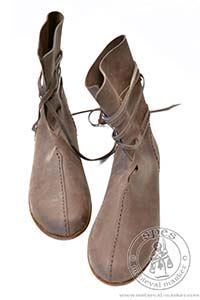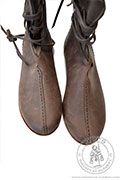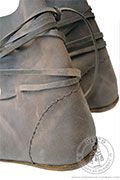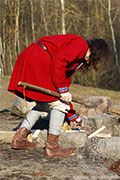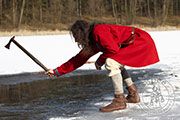If you wish to adjust your cookie preferences for this website, you can do so using your browser settings.



Category: Male clothing > medieval shoes
Viking boots for men
Viking boots for men
Century: V-IX, X, XI, XII| CODE | Material |
Standard
|
Price | |
| MSS1557 | Leather | Mixed | 165.00 EUR |
|
| MSS1560 | Leather | Mixed | 190.00 EUR |
|
Lowest price in the last 30 days
See how to place an order for several people
As you may be aware, our projects are always based on historical examples. In the case of Viking boots, and other early-medieval garments, we had to do much more research. Still, we managed to make a unique pair of Viking boots, perfect for both viking reenactment events as well as for LARP and SCA.
This pair of Viking boots for men is made from natural, elastic, plant-tanned cowhide.
This type of footwear is high, reaching the calves. It is tied up with two long leather laces, which can be used to lace up shoes as well as the upper part of calves. What is more, there is an option of rolling the upper outside, or covering the boots with woolen wrap. A characteristic feature of these Viking boots is the look of their tips and front part. Stitching at the front makes them even more similar to historical examples of Viking footwear.
Natural leather of this pair provides the comfort of wearing. If needed, one can slightly stretch the leather with the use of water and fat.
Viking boots for men are available in sizes from 41 to 46. You can have them in one of four colors: red, black, brown, and natural.
| Shoe size | 41 | 42 | 43 | 44 | 45 | 46 |
| Foot length (cm) | 26,4 cm | 27 cm | 27,7 cm | 28,4cm | 29 cm | 29,7 cm |
The Viking boots are finished and painted by hand, so colors may slightly vary from those on pictures.
Our early-medieval boots are available in two versions:
- MSS1557 - leather boots with rubber sole
- MSS1560 - leather boots with leather sole
Historical examples of Viking boots for men
Design of these boots refers to numerous findings from the 9th-11th century period, from almost all of Europe. The most characteristic examples come from the Oseberg boat (dated 9th century).Shoes in the Middle Ages
Nowadays we perceive footwear as an essential part of everyday clothing. It had similar role even hundreds years ago. A shoe protects foot against overload but also against water, cold and injuries. It also provides proper traction.Shoes were always made of 2 parts: a sole and upper. These were produced mostly of grain leather sewn together with hempen thread. Later, historical shoes became a representative symbol which indicated the wearers’ wealth and social status. The richer a person was, the more decorative their shoe was
Today we know that foot protection was popular even in prehistory. In 1991 a pair of tourists during their trek in the Alps, near Ötztal in Southern Tyrol, found frozen corpse of a man from around 3300 BC. Ötzi, as that is how the man was named, was wearing shoes from deer skin and bear sole. He had straw of grass inside the shoes. Such construction protected his feet again injuries and moisture and ensured comfort and hygiene. In the ancient times people worn usually sandals from papyrus, sometimes from leather. Romans worn leather shoes similar to sandals with full sole, often with studs. These were called caligae.
Footwear fashion evolved in the Middle Ages. Medieval shoes were produced from cattle, sheep or goat leather. They were sewn on shoemaker's lasts. The sole was mounted with nails, then other elements were sewn together. In the 12th century a shape of shoe known today came to existence. Distinctive medieval shoes with lengthened tip can be found on miniatures from 12th century onwards.
There were many ways of decorating medieval shoes. Leather was often hemmed and decorated with additional outer elements. Usually medieval footwear was cut out, punctured, stamped, embossed, embroidered, or simply additional fancy elements like pearls were sewn onto it.
Another interesting fact is connected with colour of shoes contrasting with hose. Of course, the more fancy a shoe, the wealthier his owner was. In the medieval times people believed that the less decorative shoe was, the more god-fearing and well-behaved his owner was.
In the 15th century, shoes with pointy toes gained great popularity. These were called poulaine or crakoves. Their special shape made it a bit difficult to walk in them. It was the most significant change in the European shoe shape. The people of commune wore medieval footwear with much shorter toes. Typical poulaine were accompanied by other decorations, also to underline the original outfit. However, as soon as such footwear started to be perceived as reprehensible, wearing it became forbidden.
There is a theory saying that both of these special names can be associated with Poland. In France, it was called a la Poulaine (from Poland), and in England - crakoves (from Cracow). However, scientists till this day are not sure about the correctness of this theory.
Each medieval person knew overshoes – rigid, wooden soles with heels worn under leather shoes. These protected the footwear against mud, rain or snow. Usually it was made from one piece of wood matching the size and shape of shoe and feet. They had numerous decorations like rosettes on sides or on soles. The richness of ornaments depended mostly on the wealth of owner.
Great part in discovering the history of medieval shoes was played by Gdansk city, where numerous historical footwear were found. Both male and female examples are decorated with various adornments and embroideries which gave them unusual look. Historical notations confirm that there were 3 models of footgear: for wintertime with short upper part, traditional with revealed ankles, and shoes with a deep cut-out instep and with long tips. The craftsmen of that time found inspiration in trends from France and England.
As long as the middle of 19th century, footgear was made by hand.





 Female Clothing
Female Clothing
 Accessories
Accessories Furniture
Furniture Tents
Tents Armament
Armament HMB Line
HMB Line Miscellaneous
Miscellaneous Rent
Rent In stock
In stock Special Offers
Special Offers Search
Search Your Account
Your Account About us
About us Sizing
Sizing How to buy
How to buy Blog
Blog Links
Links Events
Events
